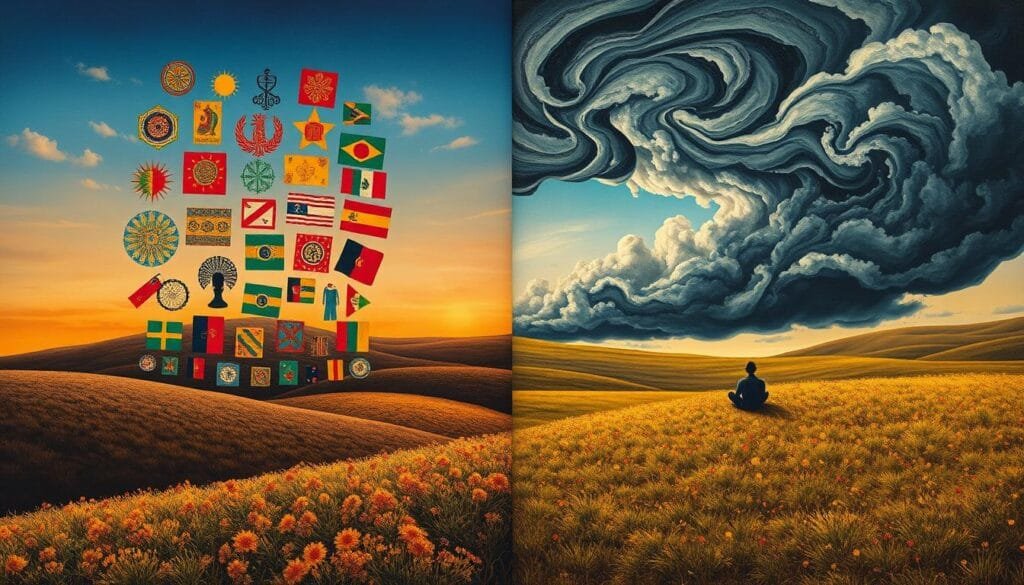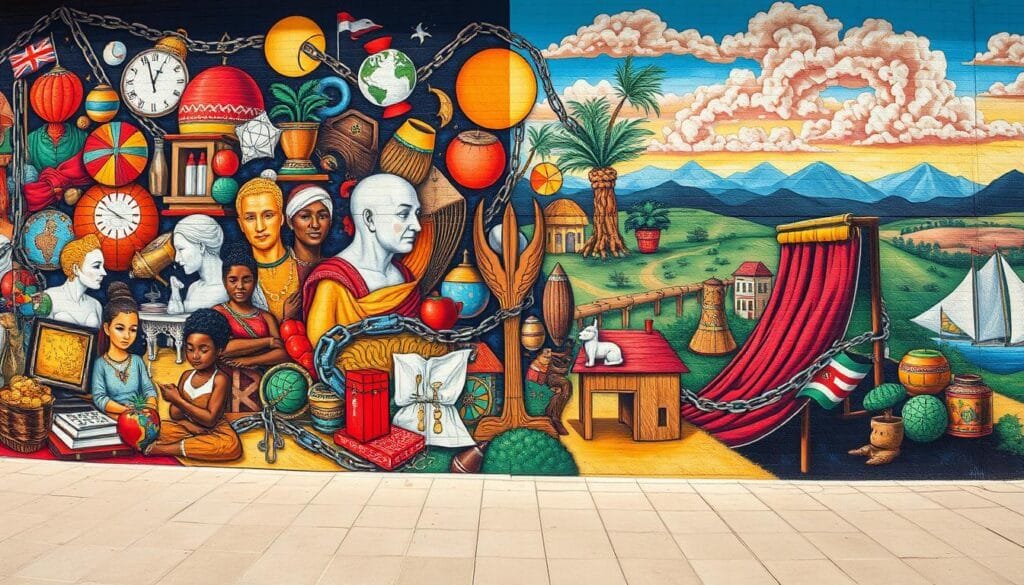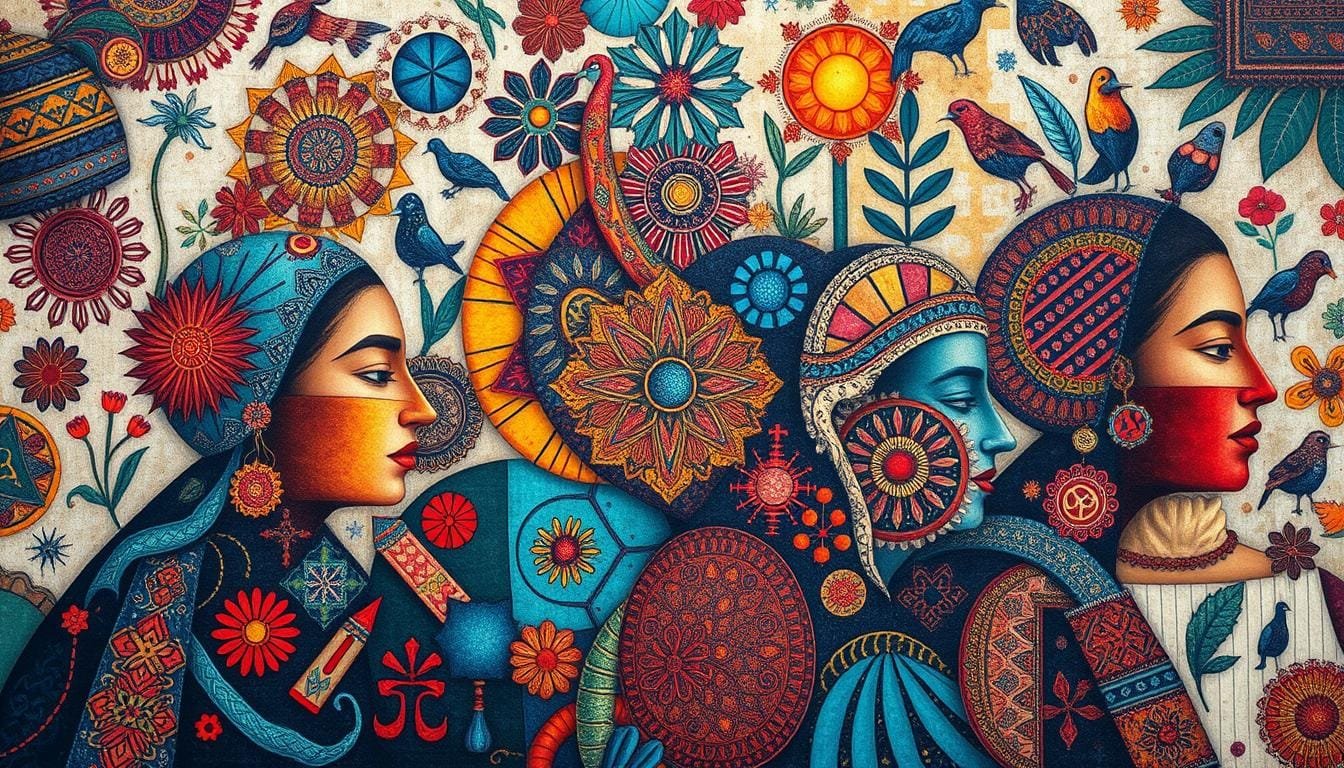Could it be that we see racism mainly through the lens of cultural norms? As we explore the link between racism and cultural identity, we find a complex picture. It impacts many people from different backgrounds. By looking at racism’s perceived and actual impacts, we understand better how it shapes identities and norms.
Racism’s effects reach further than just clear acts of hate or discrimination. Take the Christchurch mosque shootings by Brenton Tarrant, which tragically ended 51 Muslim lives. This act shows the deadly side of racial hate. But racism can also work in less obvious ways. In France, the New Right movement and Club de l’Horloge called anti-racist groups “anti-French.” They used “right to be different” to push for a separate white identity. These efforts show how cultural expectations fuel racial biases.
The New Right’s stance against multiculturalism shows another angle. They see it as a form of racism that erases real differences. Leaders like Jean-Marie Le Pen argued that cultural identity requires keeping immigrants apart. This view reminds us that fighting for identity often brings up societal norms and history. These stories affect how minority groups see themselves and link cultural identity with racism today.
Key Takeaways
- Cultural expectations play a significant role in perpetuating racism.
- The Christchurch shootings highlight the extreme impact of racial hatred.
- The New Right movement rebranded anti-racist efforts, complicating cultural identity.
- Multiculturalism is often portrayed negatively by right-wing groups, impacting racial relations.
- Historical context and intergenerational trauma profoundly affect racial identity.
Challenges Around Race and Cultural Identity
Race and cultural identity issues are complicated. They often lead to people facing both obvious and hidden discrimination. These problems deeply affect mental health and happiness. Let’s look into these challenges more.
Interpersonal Discrimination
Discrimination happens in everyday interactions in many forms. It includes racial prejudice from others based on race. This can cause a lot of emotional pain.
Racial microaggressions, like casual racially insensitive remarks, create a hostile environment. They make people feel left out and angry.
Structural and Institutional Discrimination
Discrimination is also built into society’s structures. It’s seen in rules and practices that hold back certain racial groups. This leads to unfair situations in things like schooling, jobs, and medical services.
For instance, communities of color often have a harder time getting mental health help. This makes mental health issues last longer for them compared to White people.
Micro-aggressions and Paranoia
Microaggressions are small, daily actions or words that might be racially motivated. They’re not always obvious, making them tough to point out. Yet, they cause stress over time.
The worry about facing microaggressions can make anxiety and sadness worse. Always being on guard is tiring and can make someone feel very alone.
Identity Conflicts and Questioning
Dealing with discrimination and microaggressions may lead to doubts about one’s identity. People might feel caught between different cultural expectations. This can make them feel like they don’t fit in anywhere, increasing loneliness and despair.
But, developing a strong sense of racial or cultural identity can help. It can lessen the negative effects of discrimination on mental health.
Mental Health Impacts of Racial and Cultural Identity Stress
Racial stress and cultural identity struggles can deeply affect mental health. They can lead to anxiety, depression, and chronic sadness. Racial and ethnic minorities often face special challenges. These challenges can hurt their mental health. Many studies have talked about these challenges and what they mean for mental health.
Common Symptoms: Anxiety, Depression, Sadness
Anxiety and depression are common mental health issues that come from racial stress. African American youth dealing with racism often show more anxiety and depression. In the Latinx community, facing discrimination is linked to more depression. This shows how important it is to understand different cultures in treatment.
Asian and non-Hispanic white people report facing discrimination almost weekly. This greatly affects their mental health. Such discrimination leads to higher psychological distress and chronic sadness. Also, studies show that blacks and Latinos with mental illness often have harder, longer, and more debilitating episodes than other groups.

Feelings of Isolation and Self-Doubt
Racial and cultural identity issues often bring feelings of isolation and self-doubt. Discrimination can make people feel left out, especially in communities of color. African American youth and Asian American adults have high anxiety and PTSD symptoms from racism. This shows the big impact racial stress has on mental health.
Long studies have found that racial discrimination leads to more psychological distress over time. Blacks experience more psychological distress than whites, but have less access to mental health services. This lack of access makes feelings of isolation and self-doubt worse among racial and ethnic minorities.
Many barriers keep people from getting mental health care. Things like cost, stigma, broken services, and lack of care that understands different cultures. According to Medical News Today, racism directly hurts the mental health of BIPOC individuals. There’s a big need for regular mental health checks and support for those affected.
Is Racism an Example of Cultural Identities Expectation
Racism is closely related to cultural identities and the society we live in. It’s important to look at how society’s norms and cultural expectations foster racist views. By understanding history and intergenerational trauma, we can see how these prejudices last over time.

Role of Societal Norms and Expectations
The norms of our society greatly affect how we see and treat different races. The FBI noted a 20% rise in hate crimes from 2013 to 2014. Many were due to racial hate. This shows how deep cultural expectations influence our actions towards various races.
Studies show interacting with different groups can reduce prejudice by 55%. This is because it helps break down the barriers our cultures build. However, if negative stereotypes are shared, racial prejudice can jump by 40%. This was found by Collins and Clément in 2012.
Historical Context and Intergenerational Trauma
Understanding the history of racism is key to see its effect today. Research by Pettigrew and Tropp in 2008 showed that knowing more about each other can lessen prejudice. Yet, the wounds of past wrongs lead to trauma that affects future generations and keeps bias alive.
For example, a study found that hidden biases could predict a 70% chance of unfair choices. Moreover, in 2019, there were 1,020 hate groups in the U.S., a stark indication of ongoing racism. Such trends are worrying.
Research by McConahay in 1986 showed that modern racism involves mixed feelings. People with higher levels of such racism were 30% more likely to oppose equality measures. A study by Althusser in 1971 found that 25% struggle internally with their prejudiced views. These insights show the deep roots of racism and its lasting impacts.
Strategies to Cope with Racial and Cultural Identity Challenges
Dealing with racial identity challenges requires understanding and using both active and passive ways to cope. Nearly 70% of Black Americans face racial discrimination, showing the need for strong ways to handle this stress. It’s crucial for people and groups to create lasting solutions for these pressures.

Getting mental health support is a key step. Expert advice from therapists who know the ins and outs of racial issues can really help. They offer ways to cope and a place to talk openly. Since racism can lead to feeling more depressed, this support is vital.
Expressing yourself through art, music, or writing is also helpful. It lets you express and share your feelings and connect with others facing the same issues. This can be a healing and uniting experience.
Being part of groups that provide support is critical too. It makes you feel understood and builds shared strength. For Black teens dealing with racism daily, a supportive group can lessen feelings of being alone and doubt.
Using strategies to manage your emotions well, like seeing things in a positive light, can reduce stress from racial issues. Solving problems directly and not dwelling on negative thoughts are key. This can make dealing with racial encounters easier.
Addressing unconscious biases is also essential. Through training sessions, you can learn to see and change these biases. This helps make our community more welcoming. Changing biased attitudes is possible and necessary for everyone’s progress.
In summary, combining professional mental health support with being part of a community, being creative, and thinking positively offers a good way to face racial and cultural challenges.
Conclusion
Understanding racial and cultural identity is crucial. We need to know how racism really impacts people. In previous sections, we saw how racial discrimination affects those from marginalized groups. It shapes their identity and mental health deeply. We’ve looked at families from Filipino American and Korean American backgrounds. It’s important for families to be supportive to lessen racism’s harm. For more on this topic, check out this study.
History gives us more insight, like James Baldwin’s experiences in Harlem. Baldwin talked about the tough spots Black individuals find themselves in. They face accusations of assimilating and pressures from separatist ideas that were big in the 1960s. Today, we see a rise in hate crimes and active hate groups. It shows that fighting racism is still a huge challenge. But, studies by Pettigrew and Tropp (2008) show that talking and sharing experiences can help. It can reduce prejudice and help us appreciate diversity.
To tackle these issues, we need to work together – in education, policies, and community actions. It’s vital to have open conversations, question norms, and take steps towards a welcoming environment for everyone. By doing this, we support a diverse and inclusive society. This supports everyone’s cultural identity. Working together against racism and understanding cultural identity is crucial. It’s essential for a united and fair future.
FAQ
How does racism intertwine with cultural identity expectations?
Racism affects how individuals view themselves and others within cultural settings. It breeds stereotypes and influences behavior, leading to experiences of racism.
What are some common forms of interpersonal discrimination?
Interpersonal discrimination can be things like being left out, negative remarks, and unfair treatment due to race. These actions harm someone’s feeling of acceptance and self-esteem.
How does structural and institutional discrimination differ from interpersonal discrimination?
Structural discrimination involves unfair systems in places like schools, jobs, and law that harm certain races. It works on a bigger scale than personal discrimination, making it harder to see but very harmful.
What are micro-aggressions and how do they affect individuals?
Micro-aggressions are small, often unintended, acts or words that show bias. They make people feel uncomfortable and distrusted, causing stress and emotional pain.
What types of identity conflicts and questioning can arise from racial discrimination?
Dealing with racial discrimination can make someone question their identity. This can shake their confidence in who they are and where they fit in, affecting their emotions deeply.
What mental health issues are associated with racial and cultural identity stress?
Mental health issues like anxiety, depression, and deep sadness are common. These problems can disrupt daily life and well-being, needing supportive care.
How do feelings of isolation and self-doubt manifest in those struggling with racial identity?
Isolation and self-doubt come from feeling misunderstood and unsupported. This can lead to avoiding people, losing confidence, and feeling lonelier.
In what ways do societal norms and expectations perpetuate racism?
Society’s norms and expectations keep racism going by making stereotypes and discrimination seem normal. They decide what’s seen as okay, keeping power and unfairness alive.
What is the historical context of racism, and how does it contribute to current racial dynamics?
The history of racism includes slavery, segregation, and ongoing unfair treatment. These past acts cause lasting hurt, affecting racial relations and personal experiences today.
What strategies can help individuals cope with racial and cultural identity challenges?
To cope, find supportive friends, dive into creative activities, and get mental health help. Building strength means finding ways to face racial and cultural identity issues positively.
